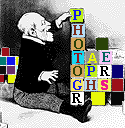The Photographers: Clyde William Hare ("Red")
Clyde Hare was born in 1927 in Bloomington, Indiana.
His first
experience with photography occurred while serving with the U.S. Navy in
the final years of WWII and involved teaching patients at a naval
hospital how to use camera controls as a rehabilitation technique.
Later, Clyde Hare took the first course offered in fine art photography
at the University of Indiana, Bloomington. After having his freelance
photographs published in several national magazines, Hare attended a
photographic workshop at the University of Missouri where he first met
Roy Stryker, the father of documentary
photography in
America. Soon after this event, Hare travelled to a regional photo
competition in Milwaukee where both Stryker and a man named John Morris
from the Ladies' Home Journal were judges. Morris was familiar
with Hare's work for the Journal and suggested that
Stryker invite him to join the Pittsburgh Photographic Library project.
In 1950, not long after graduating from Indiana University with a
degree in marketing, Clyde Hare moved to Pittsburgh to help document the
city's urban renewal for the Pittsburgh Photographic
Library. On
his first day in the city, Hare got lost somewhere in the West End in a
borrowed car he drove all the way from Indiana. But with a little help
from the locals, Hare soon found his way around and fell in love with his
newly adopted city. As a full-time PPL staff photographer, Clyde Hare
documented the demolition and reincarnation of the Point: "Downtown was
in shambles. Everywhere you looked, something big was coming down or
going up, and the earth shook from the piledriving." He also captured
images of the old sections of the North and South
Sides, as well as
the development of Pittsburgh's suburbs. At the conclusion of his PPL
assignment, Hare joined Stryker again to work on the Jones & Laughlin
Photographic File.
After the J&L project, Clyde Hare continued as a freelance
photographer and went on assignments for such national magazines as
Life, Fortune, and Time. At the National
Geographic, apart from being sent to such places as the Arctic and
northern Europe, he produced a series of photographs to complement a
26-page article on Pittsburgh. In addition, Clyde Hare has photographed
for industrial and trade magazines; worked in the areas of public
relations, design and television; collaborated on
photography exhibits; lectured; and even taught at Carnegie
Mellon University.
In 1958, Hare was the first local photographer to receive a one-man
exhibition at Carnegie Institute. He has won numerous awards, and has
been the subject of articles in national photography magazines. Of his
work, Clyde Hare says, "I made up my mind to take one great photograph
each day, one that would live, would be simple, would have something to
say."
A selection of photographs taken for both the Jones & Laughlin and
Pittsburgh Photographic Library projects are included in a recent book
entitled, Clyde Hare's Pittsburgh: Four Decades of Pittsburgh, Frozen
in Light, with text by Alan Van Dine. This handsomely produced book
was published by the Pittsburgh History and Landmarks Foundation in
1994.
Sources: The Pittsburgh Post-Gazette, Feb. 15, 1963; Post-Gazette,
Feb. 26, 1979; Pittsburgh Press, March 29, 1978; and Clyde Hare's
Pittsburgh,by Alan Van Dine (1994).
In addition to Clyde Hare's photographs at the PPL, substantial
holdings are maintained at the University of Louisville Photographic
Archives (KY) and at the Carnegie Museum of Art. Modest holdings are
housed at the George Eastman House in Rochester (NY).
Photographs by Clyde Hare
 Alcoa Building
Alcoa Building
 Cathedral of Learning
Cathedral of Learning
 Cleaning the Oliver Building
Cleaning the Oliver Building
 Construction Workers
Construction Workers
 Demolition Worker
Demolition Worker
 Fineview
Fineview
 J&L Steel Corporation
J&L Steel Corporation
 Penn-Lincoln Parkway Bridge
Penn-Lincoln Parkway Bridge
 Portrait of a Boy
Portrait of a Boy
 Pouring Cement
Pouring Cement
 Railroad Tracks
Railroad Tracks
 Riveters
Riveters
 St. John the Baptist
St. John the Baptist
 South Vocational High School
South Vocational High School
 Steelworkers
Steelworkers
 Steelworkers
Steelworkers
 Three Children
Three Children
 Troy Hill
Troy Hill
 Troy Hill
Troy Hill
 Washing Gateway Center
Washing Gateway Center
 Welder
Welder
 Welder
Welder
pd

 Alcoa Building
Alcoa Building
 Cathedral of Learning
Cathedral of Learning
 Cleaning the Oliver Building
Cleaning the Oliver Building
 Construction Workers
Construction Workers
 Demolition Worker
Demolition Worker
 Fineview
Fineview
 J&L Steel Corporation
J&L Steel Corporation
 Penn-Lincoln Parkway Bridge
Penn-Lincoln Parkway Bridge
 Portrait of a Boy
Portrait of a Boy
 Pouring Cement
Pouring Cement
 Railroad Tracks
Railroad Tracks
 Riveters
Riveters
 St. John the Baptist
St. John the Baptist
 South Vocational High School
South Vocational High School
 Steelworkers
Steelworkers
 Steelworkers
Steelworkers
 Three Children
Three Children
 Troy Hill
Troy Hill
 Troy Hill
Troy Hill
 Washing Gateway Center
Washing Gateway Center
 Welder
Welder
 Welder
Welder
